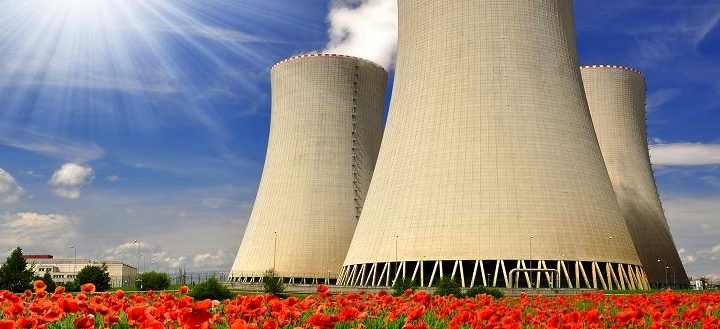Contrary to claims by opponents of nuclear energy that it is “unsafe,” “unclean,” and thus “unacceptable,” nuclear energy is the safest, cleanest, and among the most practical forms of power generation today. Unfortunately, opponents of this wonderful source of power are succeeding in their efforts to deceive people about it; and the deceived, in turn, are fueling legislation and regulations that shackle the nuclear industry. It is time to set the record straight and to defend this life-serving industry. Let us begin with a summary of the nature of nuclear energy.
Nuclear power is generated by a controlled chain reaction involving the splitting of atoms. A modern nuclear power plant uses the intense heat created by this reaction to heat water and create steam, which turns a turbine and generates electricity. Whereas a coal-fired plant heats water by burning coal, a nuclear plant heats it by splitting atoms. This process is called nuclear fission.
Nuclear fission, in simple terms, occurs when an atom splits in two, releasing a massive amount of energy and several subatomic particles called neutrons. These neutrons, in turn, hit and split other atoms, beginning and sustaining the chain reaction. Reactor operators control this reaction in a variety of ways and thus regulate the amount of heat generated and energy produced.
The raw fuel for this process is the metal uranium, which must be enriched before it can be used for producing energy in commercial reactors. Enrichment is necessary because mined uranium ore is around 99.3 percent uranium-238, which, in today’s commercial power plants, does not readily split upon exposure to neutrons from the fission chain reaction, and thus makes poor fuel. The other 0.7 percent of mined uranium is uranium-235, which makes excellent fuel. The number refers to the atomic mass, or the total mass of protons and neutrons that make up the atomic nucleus. This difference in mass of the same element makes them two different isotopes of uranium. The enrichment process consists essentially of increasing the percentage of uranium-235 by decreasing the percentage (via removal) of uranium-238.
The fuel manufacturing process ultimately yields black, pinky-sized pellets of usable nuclear fuel. These pellets are stacked in tubes of a special metal alloy, and thousands of these fuel rods are placed in a reactor core. The rods are arranged in a very specific geometric configuration to enable a sustained nuclear reaction to occur. The nuclear fission reaction is controlled by inserting or removing a separate set of rods made of neutron-absorbing metal or by adding neutron-absorbing chemicals to the water that cools the reactor.
All methods of producing energy involve risk, and nuclear fission is no exception. Historically, however, nuclear power has been by far the safest form of energy production among reliable and scalable energy sources. . . .
You might also like
Endnotes
1 “Plant Vogtle Units 3 and 4,” Georgia Power, http://www.southerncompany.com/what-doing/energy-innovation/nuclear-energy/pdfs/vogtle-nuclear-brochure.pdf (accessed July 26, 2013).
2 A terawatt-year is 8.76 x 1012 kilowatt-hours. For a further description, see “Energy Units,” American Physical Society, 2013, http://www.aps.org/policy/reports/popa-reports/energy/units.cfm.
3 “Environment and Health in Electricity Generation,” World Nuclear Association, December 2012, http://www.world-nuclear.org/education/ehs.html.
4 “Nuclear Waste: Amounts and On-Site Storage,” Nuclear Energy Institute, http://www.nei.org/resourcesandstats/nuclear_statistics/nuclearwasteamountsandonsitestorage/ (accessed December 20, 2012).
5 “The Real Waste Problem, Solar Edition,” Things Worse Than Nuclear Power, http://www.thingsworsethannuclearpower.com/2012/09/the-real-waste-problem-solar-edition.html (accessed April 27, 2013).
6 Thomas Eiden, “Energy Density of Uranium,” Power for Progress, January 18, 2013, http://thomaseiden.com/index.php/energy-density-of-uranium/.
7 “Radiation,” Greenpeace International, February 2012, http://www.greenpeace.org/usa/PageFiles/391730/Radiation.pdf.
8 S. M. J. Mortazavi and H. Mozdarani, “Non-Linear Phenomena in Biological Findings of the Residents of High Background Radiation Areas of Ramsar,” International Journal of Radiation Research, January 2013, vol. 11, no. 1, http://www.academia.edu/3390583/Non-linear_phenomena_in_biological_findings_of_the_residents_of_high_background_radiation_areas_of_Ramsar.
9 “Nuclear Facts,” Sierra Club, http://www.sierraclub.org/nuclear/factsheet.aspx (accessed December 20, 2012).
10 “Health Effects of the Chernobyl Accident: An Overview,” World Health Organization, April 2006, http://www.who.int/ionizing_radiation/chernobyl/backgrounder/en/index.html.
11 “Backgrounder on the Three Mile Island Accident,” Nuclear Regulatory Commission, February 11, 2013, http://www.nrc.gov/reading-rm/doc-collections/fact-sheets/3mile-isle.html.
12 “Japan Radiation Map,” Institute for Information Design, http://jciv.iidj.net/map/ (accessed July 30, 2013).
13 “Old People Suffer Abandonment, Cold in Wake of Tsunami,” NBC News, March 18, 2011, http://www.msnbc.msn.com/id/42150705/ns/world_news-asia_pacific/t/old-people
-suffer-abandonment-cold-wake-tsunami/.
14 “NRDC: Litigation Team,” Natural Resources Defense Council, http://www.nrdc.org/about/staff/litigation.asp (accessed April 5, 2013). “U.S. Nuclear Regulatory Commission Halts Nuclear Reactor Licensing Decisions in Response to NRDC Lawsuit,” Natural Resources Defense Council, August 14, 2012, http://www.nrdc.org/nuclear/NRC-waste-confidence-decision.asp.
15 Kristi E. Swartz, “Groups Sue to Stop Vogtle Expansion Project,” Atlanta Journal Constitution, February 16, 2012, http://www.ajc.com/news/business/groups-sue-to-stop-vogtle-expansion-project/nQRN3/; “Vermont Yankee Nuclear Power Corp. v. Natural Resources Defense Council,” Environmental Law Reporter, http://elr.info/litigation/%5Bfield_article_volume-raw%5D/20288/vermont-yankee-nuclear-power-corp-v-natural-resources-de (accessed August 1, 2013).
16 “Electric Power Annual,” U.S. Energy Information Administration, http://www.eia.gov/electricity/annual/html/epa_08_04.html (accessed April 28, 2013).
17 “NRDC: Renewable Energy for America: Technologies,” Natural Resources Defense Council, http://www.nrdc.org/energy/renewables/technologies.asp (accessed December 20, 2012).
18 “Nuclear Power in the USA,” World Nuclear Association, April 2013, http://www.world-nuclear.org/info/Country-Profiles/Countries-T-Z/USA--Nuclear-Power/#.UV6SlpM2bzw.
19 Bernard Cohen, Costs of Nuclear Power Plants—What Went Wrong? (New York: Plenum Press, 1990), http://www.phyast.pitt.edu/~blc/book/chapter9.html.
20 “mPower Empowered by SMR Funds,” World Nuclear News, November 12, 2012, http://www.world-nuclear-news.org/NN-mPower_empowered_by_SMR_funds_121112a.html; “NRC: Fact Sheet on Reactor License Renewal,” U.S. NRC, June 19, 2012, http://www.nrc.gov/reading-rm/doc-collections/fact-sheets/fs-reactor-license-renewal.html.
21 “Vermont Yankee Wins Right to Keep Generating,” World Nuclear News, January 20, 2012,
http://www.world-nuclear-news.org/RS_Vermont_Yankee_wins_right_to_keep
_generating_200112a.html.
22 “Anti-nuclear Protests in the United States,” Wikipedia, http://en.wikipedia.org/w/index.php?title=Anti-nuclear_protests_in_the_United_States&oldid=548634094.
23 “Environment: The Siege of Seabrook,” Time, May 16, 1977, http://www.time.com/time/magazine/article/0,9171,918965,00.html.
24 “German Nuclear Protest Halts Train,” Mail Online, http://www.dailymail.co.uk/news/article-34011/German-nuclear-protest-halts-train.html (accessed July 21, 2013).













